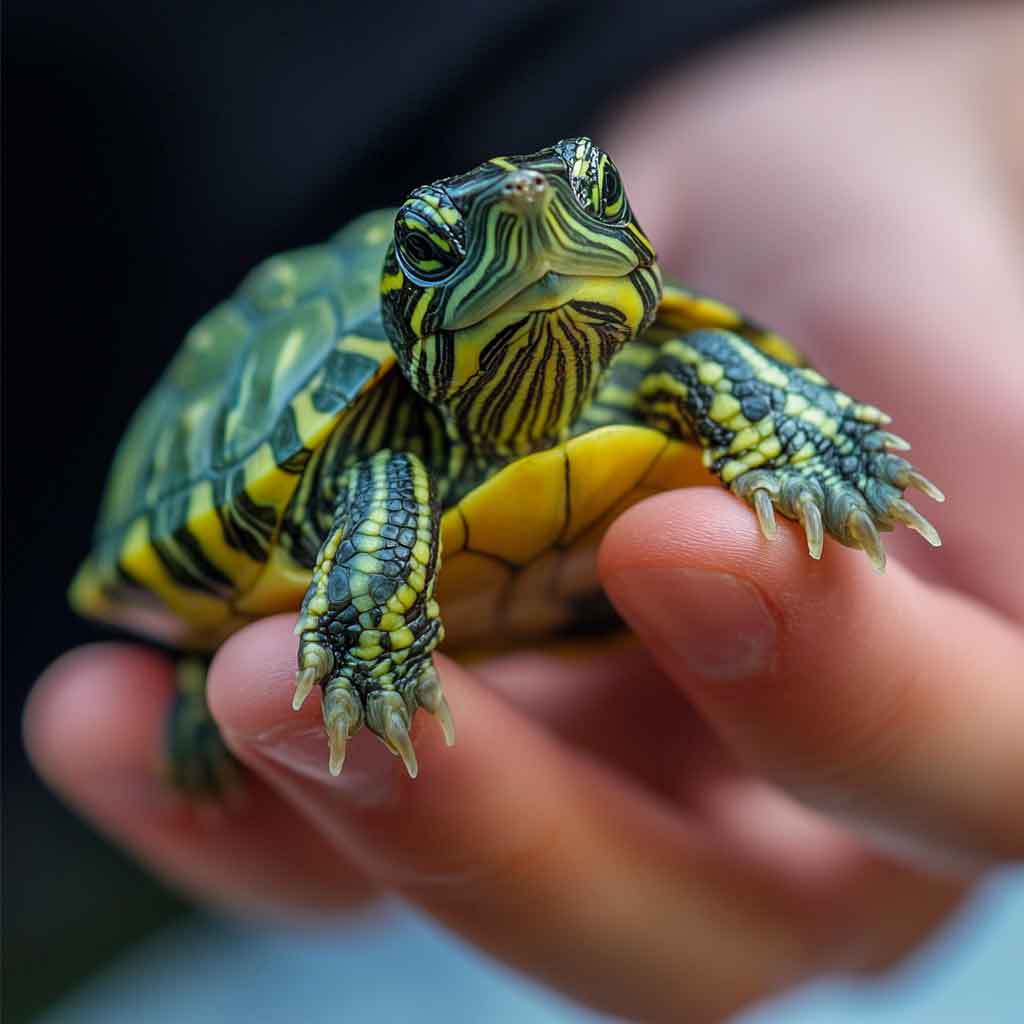How to Trim a Turtle’s Nails Safely: Ideal Length & Step-by-Step Guide
Turtles, whether terrestrial or aquatic, require proper nail care to maintain their health and mobility. Overgrown nails can cause discomfort, affect their ability to walk or swim, and even lead to infections. This guide will walk you through the process of trimming your turtle’s nails safely and explain how long they should be for optimal…
Turtles, whether terrestrial or aquatic, require proper nail care to maintain their health and mobility. Overgrown nails can cause discomfort, affect their ability to walk or swim, and even lead to infections. This guide will walk you through the process of trimming your turtle’s nails safely and explain how long they should be for optimal health.
In this article, we’ll cover the steps to trim your turtle’s nails, the ideal nail length, tools you’ll need, and factors that influence nail growth. Let’s dive into the essentials of turtle nail care.
Why is trimming a turtle’s nails important?
Trimming a turtle’s nails is a critical aspect of their care. Nails that grow too long can curl, making it difficult for turtles to move properly. For aquatic turtles, overgrown nails may hinder swimming, while terrestrial turtles may struggle to walk on uneven surfaces. Additionally, long nails can get caught on objects, leading to injury or stress.
Regular nail trimming also prevents health issues like infections or ingrown nails, which can occur if nails are neglected. By keeping their nails at an appropriate length, you ensure your turtle remains active, comfortable, and healthy.
Factors affecting turtle nail growth
Several factors influence how quickly a turtle’s nails grow and how often they need trimming:
Species of turtle
Different turtle species have varying nail growth rates. For example, red-eared sliders (aquatic turtles) may need more frequent trimming than box turtles (terrestrial turtles) due to their environment and activity levels.
Diet and nutrition
A balanced diet rich in calcium and vitamins supports healthy nail growth. Poor nutrition can lead to brittle or overly fast-growing nails, requiring more frequent care.
Environment
Turtles in captivity may not naturally wear down their nails as they would in the wild, where rough surfaces like rocks help keep nails in check. Smooth tank surfaces or lack of basking areas can lead to faster nail growth.
Age
Younger turtles tend to have faster-growing nails as their bodies develop. Older turtles may have slower nail growth but can still develop overgrown nails if not monitored.
How to safely trim a turtle’s nails

Trimming a turtle’s nails requires patience, the right tools, and a calm approach to avoid stressing your pet. Here’s a step-by-step guide to help you get started:
Tools you’ll need
- Pet nail clippers: Small, sharp clippers designed for pets or birds work best. Avoid human nail clippers, as they’re not suited for turtle nails.
- Styptic powder: This stops bleeding in case you accidentally cut the quick (the blood vessel inside the nail).
- Towel or cloth: To gently restrain your turtle and keep it calm.
- Magnifying glass (optional): Useful for identifying the quick in smaller turtles with tiny nails.
Preparing your turtle
Before trimming, ensure your turtle is calm. Handle them gently and place them on a soft surface, like a towel, to prevent slipping. If your turtle is particularly active, you may need a second person to help hold them steady.
Identifying the quick
The quick is the pink or reddish part of the nail that contains blood vessels and nerves. Cutting into the quick can cause pain and bleeding, so you’ll want to trim only the clear or white part of the nail. In turtles with darker nails, use a light source to locate the quick more easily.
How to safely trim a turtle’s nails
Step-by-step trimming process
- Secure your turtle: Gently wrap your turtle in a towel, leaving one leg exposed at a time. This keeps them calm and prevents sudden movements.
- Locate the nail to trim: Hold the turtle’s leg gently but firmly. Use a magnifying glass if needed to see the nail clearly.
- Trim small amounts: Using pet nail clippers, trim a small portion of the nail, staying well away from the quick. It’s better to trim less and make multiple cuts than to cut too much at once.
- Check for bleeding: If you accidentally cut the quick and the nail bleeds, apply styptic powder immediately to stop the bleeding. Press gently for a few seconds.
- Repeat for other nails: Move to the next nail, working slowly and calmly. Take breaks if your turtle seems stressed.
- Reward your turtle: After trimming, offer a favorite treat or place your turtle in a comfortable environment to relax.
How often should you trim?
The frequency of nail trimming depends on the turtle’s species, environment, and growth rate. On average, most turtles need their nails trimmed every 2-4 months. Monitor your turtle’s nails regularly to determine the right schedule. If you notice difficulty in movement or overly long nails, it’s time for a trim.
How long should a turtle’s nails be?
The ideal nail length varies by species but generally, turtle nails should be short enough to allow natural movement without curling or interfering with their activities. Here’s a guideline:
- Aquatic turtles: Nails should be short, about 1-2 mm beyond the quick, to avoid hindering swimming or basking. Red-eared sliders, for example, often have slightly longer front nails for digging or mating, but these should still be kept manageable.
- Terrestrial turtles: Nails should be just long enough to grip surfaces (about 2-3 mm beyond the quick) but not so long that they curl under the toes. Box turtles, for instance, need nails that allow them to walk comfortably on varied terrain.
Signs of nails that are too long
- Nails curl under the toes or touch the ground when the turtle walks.
- Difficulty swimming or climbing onto basking platforms (for aquatic turtles).
- Nails catching on tank decorations or substrates, causing stress or injury.
Signs of nails that are too short
- Trimming too close to the quick can cause discomfort or bleeding.
- Nails that are too short may make it hard for terrestrial turtles to grip surfaces.
Common mistakes to avoid when trimming turtle nails
Trimming turtle nails can be tricky, especially for first-time owners. Here are some pitfalls to watch out for:
Cutting too much at once
Trimming too close to the quick can cause pain and bleeding. Always trim small amounts and check the nail after each cut.
Using dull or improper tools
Dull clippers can crush the nail instead of cutting cleanly, leading to splintering or discomfort. Invest in high-quality pet nail clippers for precise cuts.
Stressing the turtle
Rushing the process or handling the turtle roughly can cause stress, making future trims more difficult. Work in a quiet environment and take breaks as needed.
Ignoring signs of infection
After trimming, check for signs of redness, swelling, or discharge around the nails. These could indicate an infection, requiring veterinary attention.
When to seek professional help
While trimming your turtle’s nails at home is manageable with the right tools and techniques, there are situations where professional assistance is recommended:
- Overgrown or ingrown nails: If nails have curled significantly or grown into the toe, a veterinarian or professional reptile groomer can safely address the issue.
- Nervous or aggressive turtle: If your turtle is too stressed or difficult to handle, a professional can trim the nails without causing harm.
- Signs of infection or injury: Redness, swelling, or abnormal nail growth may indicate a health issue that requires veterinary care.
- Uncertainty about the quick: If you’re unable to locate the quick or are unsure about trimming, consult a vet to avoid accidental injury.
A veterinarian experienced with reptiles can also provide guidance on your turtle’s specific nail care needs based on its species and health.
FAQs
1. Can I use human nail clippers to trim my turtle’s nails?
No, human nail clippers are not suitable for turtles. They can crush or splinter the nail, causing discomfort. Use pet-specific nail clippers designed for small animals or birds for safe and precise trimming.
2. How do I know if my turtle’s nails are too long?
If the nails curl under the toes, interfere with walking or swimming, or catch on objects, they’re likely too long. Check regularly to ensure they’re at an appropriate length (1-3 mm beyond the quick, depending on the species).
3. What should I do if I accidentally cut the quick?
If you cut the quick and the nail bleeds, apply styptic powder immediately to stop the bleeding. Press gently for a few seconds and monitor the nail for signs of infection. Consult a vet if bleeding persists.
4. Do all turtles need their nails trimmed?
Not all turtles require regular trimming. Turtles in the wild or those in enclosures with rough surfaces may naturally wear down their nails. However, captive turtles with smooth tank surfaces often need periodic trimming.
Final Word
Proper nail care is essential for your turtle’s health and comfort. By trimming their nails every 2-4 months and keeping them at an ideal length (1-3 mm beyond the quick, depending on the species), you can prevent mobility issues, injuries, and infections. Use the right tools, trim carefully to avoid the quick, and monitor your turtle’s nails regularly to ensure they remain in good condition.
If you’re ever unsure about trimming or notice signs of nail-related health issues, don’t hesitate to consult a reptile veterinarian. With consistent care, your turtle will stay happy, active, and healthy for years to come.







